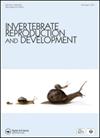Electra vs Callopora:白海中两种苔藓虫的生活史及其繁殖策略的对比
IF 0.8
4区 生物学
Q4 REPRODUCTIVE BIOLOGY
引用次数: 6
摘要
摘要:本文首次利用群落制图技术,描述了生活在白海海带上的两种常见的北北极苔藓虫——毛栉水母(Electra pilosa)和临界栉水母(Callopora craticula)的生活史。通过记录动物状态,季节性地追踪群体功能动态(性、摄食、萌芽和返老还童)。在无冰季节,合子产卵的数量由三代代表-越冬(母代)和两代幼代(女儿和孙女)。越冬的蜂群表现出两阶段的繁殖,而“早期”的子代蜂群只繁殖一次。“晚期”殖民地,连同外孙女一代,仍然是不育的。据描述,育雏鱼有4代,其中3代连续产卵。虽然这两个物种在同一基质上共存,但毛螺的繁殖开始晚了近1个月(6月下旬),这可能是由于初夏浮游植物的丰度不足,无法支持卵发生和哺育cyphonautes幼虫。估计最大菌落寿命分别为13个月和15个月。白海苔藓虫生殖生态的广泛比较表明,它们的生活史比以前认为的更加多样化、复杂和进化灵活。本文章由计算机程序翻译,如有差异,请以英文原文为准。
Electra vs Callopora: life histories of two bryozoans with contrasting reproductive strategies in the White Sea
ABSTRACT The life histories of two common boreal-Arctic bryozoans – Electra pilosa and Callopora craticula – living on kelps in the White Sea are described for the first time using colony mapping. Colony functional dynamics (sexual, feeding, budding and rejuvenation) was traced seasonally via recording zooidal states. During the ice-free season the population of the zygote spawner E. pilosa was represented by three generations – overwintered (maternal) and two young ones (daughter and granddaughter). The overwintered colonies exhibited two-phased reproduction and the ‘early’ daughter colonies reproduced just once. ‘Late’ colonies, together with the granddaughter generation, remained sterile. Four generations are described for the brooder C. craticula, three of which continuously produced larvae. While the two species co-exist on the same substratum, reproduction in E. pilosa started almost 1 month later (in late June), which could be explained by the insufficient abundance of phytoplankton in early summer to support the start of oogenesis and feeding cyphonautes larvae. The estimated maximal colony lifespan is 13 months in E. pilosa and 15 months in C. craticula. The broad comparison of bryozoan reproductive ecology in the White Sea showed that their life histories are much more diverse, complex and evolutionarily flexible than previously acknowledged.
求助全文
通过发布文献求助,成功后即可免费获取论文全文。
去求助
来源期刊
CiteScore
1.90
自引率
0.00%
发文量
21
审稿时长
>12 weeks
期刊介绍:
Invertebrate Reproduction & Development ( IRD) presents original research on the reproductive and developmental biology of the Invertebrata, both embryonic and postembryonic. IRD welcomes papers reporting significant results obtained using new techniques. Encouraged topic areas include: aquaculture, physiology, biochemistry, functional morphology, phylogeny, behavioural and regulatory mechanisms, including genetic, endocrine and molecular studies. Papers containing qualitative descriptions of reproductive cycles and gametogenesis will not be considered. IRD is published in association with the International Society of Invertebrate Reproduction and Development.

 求助内容:
求助内容: 应助结果提醒方式:
应助结果提醒方式:


